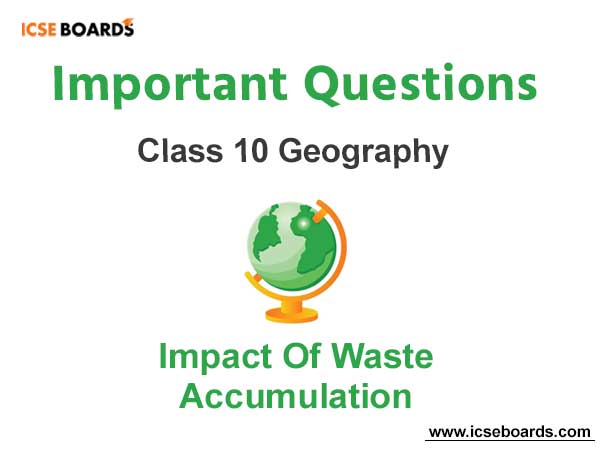Students of ICSE Class 10 should refer to Impact Of Waste Accumulation ICSE Class 10 Geography Questions below which have come in past board exams. You should always go through questions that have come in previous years. This will help you to understand the pattern of questions in ICSE Class 10 Geography and prepare accordingly. This will help you to get better marks in ICSE Class 10 Board Exams
ICSE Class 10 Geography Impact Of Waste Accumulation Important Questions
Students should learn the important questions and answers given below for Chapter Impact Of Waste Accumulation national Sources Of Energy in Geography for ICSE Class 10. These board questions are expected to come in the upcoming exams. Students of ICSE Class 10th should go through the Important questions and answers ICSE Class 10 Geography which will help them to get more marks in exams.
Board Exam Questions Impact Of Waste Accumulation ICSE Class 10 Geography
Question. Name the disease caused by mercury contamination in Japan.
Answer: Minamata disease.
Question. Name the gas produced by the decomposition of accumulated waste. Why is this gas harmful ?
Answer: (i) Methane gas is produced by decomposition of the waste, which is highly explosive.
(ii) So it has to be managed properly to avoid the bad results creating large scale loss and unwanted problems.
Question. What is the effect of acid rain on monuments ?
Answer: (i) A chemical reaction occurs between the acids of the acid rain and the buildings. It exerts pressure on the monument surface leading to corrosion of its body.
(ii) The gypsum and calcium sulphate are washed away by water causing damaging marks on statues and monuments.
(iii) Limestone statues are also destroyed naturally because carbonic acid in rainwater converts limestone into bicarbonate which is water soluble and is washed away.
Question. Explain the effect of accumulation of solid waste on terrestrial life.
Answer: (i) Scavangers and stray animals like dogs, rats, pigs and cows are directly affected by waste when they feed on the waste for food. Sometimes
these animals consume toxins or non-degradable substances like plastic carry bags present in the waste and die.
(ii) The wastes consumed by animals also lead to many diseases and other problems. For example, according to a study, mice that were fed on high levels of toxins had difficulty in reproducing and so did their offspring. These offspring also had higher rates of birth defects and lower body weights.
(iii) Similarly, birds do get the adverse impact of feeding on waste. Some of the toxins have been shown to have made birds ill after consuming such toxins from the wastes. Birds feeding on agricultural waste suffer from defective egg shells and increased mortality.
Question. How do solid waste affect landscape ?
Answer: Dumping of solid waste not only gives an ugly look and foul smell but also causes serious health problems. It sometimes leads to outbreak of epidemics.
Question. What is known as the Minamata Disease ?
Answer: (i) Minamata, a coastal town of Japan, had a factory of Vinyl Chloride in 1952. It used to discharge effluents with methyl mercury into the sea.
(i i) Methyl mercury can break the barrier between blood cells and nerve cells. Thus, it reaches brain to cause progressive irreversible damage.
(iii) In 1953 some fishermen fell ill in Minamata and their illness was detected to be caused by consuming fishes caught from the Minamata Bay.
(iv) Fishing in Minamata Bay was banned in 1957, as mercury was identified to be the reason for toxicity.
(v) The epidemic in Minamata is now known as ‘Minamata Disease’. Mercury in Minamata contaminated and killed different sea bird species feeding on fishes.
Question. What impact does the decomposition of waste in the open areas have on human health ? OR Explain the impact of waste accumulation on human health.
Answer: (i) Accumulated solid wastes when left uncared, start decomposing. A number of pathogenic (disease-producing) bacteria, virus and fungi grow from these wastes.
(ii) Files, insects, rodents etc., live in the accumulated waste heaps and carry germs of various diseases to human habitation.
(iii) Decomposition of wastes produces harmful gases that pollute the air around us
Question. Give two consequences of dumping solid wastes on landscape.
Answer: (i) Much of the world’s solid waste is simply dumped onto vacant land and left to decompose.
(ii) Open dumps not only ruin the natural beauty of the land but also provide a home to rats and other disease carrying organisms.
(iii) Both open dumps and landfills may contain poisonous substances that seep into the ground water or flow into steams and lakes.
Question. Name three monuments affected by acid rain.
Answer: Many monuments are affected by acid rain. Examples are: the Parthenon of Athens, the Colosseum of Rome, the Taj Mahal of Agea, Lincoln Memorial of Washington, Parliament Building of Ottawa, Houses of Parliament in London. Cathedral of Cologne, the Learning Tower of Pisa, the Tower of London, etc.
Question. What is known as eutrophication ?
Answer: (i) Eutrophication is the process of depletion of oxygen from water bodies occurring either naturally or due to human activities.
(ii) The process of eutrophication takes place due to introduction of nutrients and chemicals through discharge of domestic sewage, industrial effluents and fertilizers from agricultural fields.
Question. Why is the handling of solid wastes a major problem ?
Answer: (i) Various things in the solid wastes are non-degradable and may cause serious problems for environment and ecology through large scale pollution of land, soil water and air.
(ii) These may result in health hazards, animal and plant life.
(iii) If the solid wastes are dumped deep into the ground, it may pollute the soil and water by seepage through rainfall water and may harm a large area with infection and unhealthy materials.
Question. How is the ‘use and throw’ concept responsible for the rease in waste generation ?
Answer: (i) With the use and throw concept, the generation of wastes has increased alarmingly, both in quantity and complexity.
(ii) One can see heaps of solid wastes accumulated in street corners, around hospitals, school backyards and even near water bodies.
(iii) Dumping of solid wastes not only gives an ugly look and foul smell, but also causes serious health hazards. Sometimes, the outbreak of epidemics takes place due to the accumulation of wastes, particularly near water bodies.
Question. How does waste accumulation affect the environment ?
Answer: (i) Accumulated solid wastes when left uncared for starts decomposing and produce pathogens, viruses and fungi which grow in this waste.
(ii) Flies, insects and rodents live in these waste, carry germs of various diseases.
(iii) Rain water carries decomposed waste into waterbodies and causes water pollution.
Question. Why are radioactive wastes more hazardous than other wastes ?
Answer: (i) Radioactive waste produced by nuclear reactors and weapon factories cause a potentially serious environmental problem.
(ii) Radioactive waste, although present in small quantities, remains extremely harmful to human health for many years.
EFFECTS OF TOXIC PARTICULARS MATERIALS
1. Lead : Affects blood system, causes behavioural disorders and can also cause death.
2. Cadmium : Causes cardiovascular diseases and hypertension, kidney damage
3. Nickel : Causes respiratory problems, lung cancer.
4. Mercury : Causes nerve and brain damage, kidny damage.
5. Beryllium : Causes berylliosis. Affecting mucus membrane of eyes and lungs. Causes shortness of breath, weight loss, lung cancer and affects heart.
6. Asbestos : Causes asbestosis, shortness of breath and lung cancer
Question. Explain how eutrophication affects aquatic life.
Answer: (i) It is the process of depletion of oxygen from water bodies occurring either naturally or due to human activities. The process of eutrophication takes place due to introduction of nutrients and chemicals through discharge of domestic sewage, industrial effluents and fertilizers from agricultural field.
(ii) Algae and phytoplankton use carbon dioxide, inorganic nitrogen and phosphate from the water as food. They serve as food for microscopic animals (zooplankton). Small fish feed on these zooplanktons and large fish in turns consume these small fish.
(iii) When nutrients become abundant due to waste accumulation, the growth of phytoplankton and algae increases.
(iv) Consequently, the penetration of oxygen, light and heat into the waterbody is reduced. This causes death of most of the aquatic organisms, draining water of all its oxygen.
Question. What can be the effects of Biomagnification on human beings ?
Answer: (i) ‘Biomagnification’ is the increasing concentration of various toxic materials in the food chain, which may extremely damage marine life by checking photosynthesis process.
(ii) Mercury water causes failure of various organs, in the marine organisms.
Question. State the main objective of the treatment of gaseous waste.
Answer: To minimize the generation of gaseous waste.
Question. What is biomagnification ?
Answer: (i) The term Biomagnification means increasing the concentration of various toxic substances along the food chain.
(ii) Toxic substances at the level of primary producers get concentrated at each trophic level as they move up the food chain.
Question. What caused Minamata Disease ?
Answer: Discharge effluents with methyl mercury into the sea.
Question. “The waste accumulation damages the aesthetic of the area.” Justify by giving two reasons.
Answer: (i) When the waste is dumped in an improper way, the landscape of the area gives unpleasant look.
(ii) The uncontrolled dumping of urban waste damages the beauty of the countryside.
Question. What is acid rain ? Mention two of its effects.
Answer: Burning of coal, fuel wood of petroleum produce sulphur and nitrogen which react with oxygen and are converted into their respective oxides – sulphur oxide and nitrogen dioxide. These oxides react with water vapour present in the atmosphere to form acids like sulphuric acid and nirtic acid. These acids precipitate with rain to form acid rain.
Effects :
(i) Acid rain severely damages the various ecosystems in many parts if the world. Many forests and lakes have been damaged by it.
(ii) When acid rain pours on soil, it destroys the nutrients of the soil and reduce its fertility.
Question. What is meant by the use and throw concept with respect to waste generation ?
Answer: Use and throw means practice of discarding things after using them once. This increases the waste. eg. Disposable plates, glasses etc.
Question. What harm is done by dumping of waste near water bodies?
Answer: (i) Waste dumped near a water source percolates through the soil into the waterbodies and contaminate the water.
(ii) Direct dumping of untreated waste in rivers, seas and lakes results in the accumulation of toxic substances in the food chain through plants and animals that feed on it (biomagnification).
(iii) Choking of drains and gully pits by the solid wastes results in water logging, especially during the rainy season. The water logging results in breeding of mosquitoes in the stagnant water which spread diseases like malaria and chickengunia.







